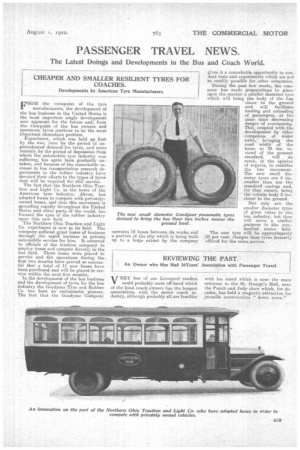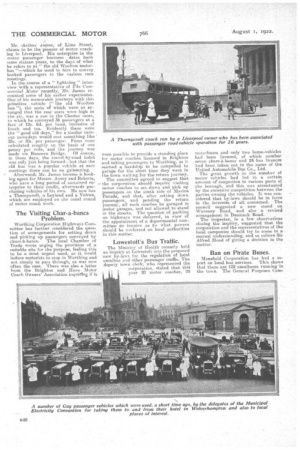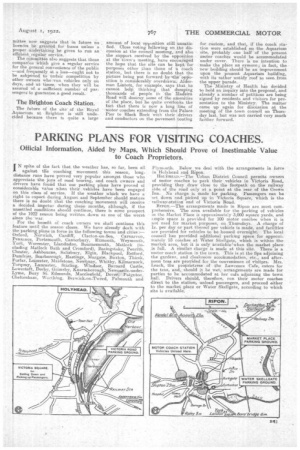PASSENGER •TRAVEL NEWS.
Page 23

Page 24

Page 25

If you've noticed an error in this article please click here to report it so we can fix it.
The Latest Doings anti Developments in the Bus and Coach World.
'CHEAPER AND SMALLER RESILIENT TYRES FOR COACHES.
Developments by American Tyre Manufacturers.
FROM the viewpoint of the tyre manufacturers, the development of the bus business in the 'United States is the most important single development now apparent for the future and, from the viewpoint of the bus owners and operators, tyres continue to be the most, important immediate problem. Experiment, which was held up first, by the war, later by the period of unprecedented demand for tyres, and more recently by the period of depression from which the automobile tyre industry was suffering, has again been gradually untaken, and because of the remarkable increase in bus transportation research departments in the rubber industry have devoted their efforts to the types of tyres that will be required forthis service.
'The fact that the Northern Ohio Traction and Light Co. in the home of the American tyre industry, Akron, has adapted buses to cempete with privatelyowned buses, and that this movement is spreading rapidly throughout the United States rand other parts of the world, has focused the eyes of the rubber industry upon this new field.
The Northern Ohio Traction and Light Co. experiment is new in its field. The company suffered great, losses of business through the rapid increase in private. automobile service for hire. It occUrred to officials of the traction company to employ buses and compete directly in the bus • field. Three buses were placed in service and the operations during the. first two months have proved so successful that a total of II new buses have been purchased and will be placed in service within the next five months.
In the development of the bus business and the development of tyres for the hus industry the Goodyear Tyre and Rubber Co. has been an enthusiastic pioneer. The fact that the Goodyear CoMpany. operates 19 buses between its works and a portion of the city which is being built up to a large extent by the company . gives it a remarkable opportunity to conduct tests and experiments which are not so readily possible for other companies.
During the past few weeks, the company has made preparations. to place ' upon the market a smaller diameter tyre which will bring the body of the bus closer to the ground and will facilitate loading and unloading of passengers, at the same time decreasing danger of overturning. This, coupled with the development by other companies of wider axles, bringing the road width of the buses to 70 ins, instead of the present standard, will do much, in the opinion of experts, to stabilize the bus movement. The new small diameter tyres are 4 ins. smaller than are the standard casings and, for that reason, bring the vehicle body 2 ins. closer to the ground.
Not only are the smaller diameter tyres of great value to the bus industry, but they will serve a similar purpose in ',the commercial' motor field.
The new tyre will be approximately 25 per cent, cheaper than tyres formerly offered for the same, service.
REVIEWING THE PAST.
An Owner who Has Had 16Years' Association with Passenger Travel.
VERY few of our Liverpool readers could probably state off-hand which of the local coach owners has the longest. associations with the motor coach industry, although Probably all are familiar
with his stand .which is near the main entrance to the St. George's Hail, near the Punch and Judy show which, for decades, has held a magnetic attraction for juvenile excursionists " down town." Mr. -Arthur Jam.es, of Lime Street, claims to be the pioneer of motor coaching in Liverpool. His enterprise in the motor passenger business dates back some sixteen years, to the days of what he refers to as " the old Wootton motorbus "—which he used to hire to convey, booked passengers to the various race meetings.
In the course of a " lightning " interview With a representative of The Commercial Motor recently, Mr. James recounted some of his earlier experienees. One of his memorable journeys with this primitive vehicle(" the old Wootton bus "), the seats of which were so arranged that the rear seats were high in the air, was a run to the Chester races, to which he conveyed 36 passengers at a fare of 12s. 6d. per head, inclusive of lunch and tea. Evidently these were the " good old days," for a similar turn. out nowadays would cost something like ' 25s. or 30s. per passenger. Fares were calculated roughly on the basis of one penny per mile, and the journey was made via Runcorn Bridge. Of course, in those days, the travel-by-road habit was only just being formed—but that the old. bus was a popular vehicle at race meetings there can be no gainsaying.
Afterwards Mr. James became a booking agent for Messrs. Avery and Roberts, who have a long period of sustained enterprise to their credit, afterwards purchasing vehicles of his own. He now has a Thornycroft, a Leyland and a Vulcan, which are employed on the usual round of motor coach work.
The Visiting Char-a-banes • Problem.
Worthing Corporation Highways Committee has further considered the question of arrangements for setting down and picking up passengers conveyed by charsza-banes. The local Chamber of Trade wrote urging the provision of a suitable site for the purpose, feeling this to be a most urgent need, as it would induce motorists to stop in Worthing and not simply to pass through, as was now often the case. There was also a letter from the Brighton and Hove Motor Coach Owners' Association inquiring if it
were possible to provide a standing place for motor coaches licensed in Brighton and taking passengers to Worthing, as it seemed a hardship to be compelled to garage fO'r the short time they were in the t' own waiting for the return journey. The committee agreed to suggest that the corporation should require visiting motor roaches to set down and pick up passengers on the south side of Marine Parade, and that, after setting down passengers, and pending the return journeei, all such coaches be garaged in motor garages, and not allowed to stand in the streets. The question of parking on highways was deferred, in view of the appointment of a departmental committee to inquire as 'yto what powers should be conferred on local authorities in this matter.
Lowestoft's Bus Traffic.
The Ministry of Health recently held an inquiry at Lowestoft into the proposed new by-laws for the regulation of local omnibus and other passenger traffic. The deputy town clerk, who represented the corporation, stated that this year 20 motor coaches, 2c1 :motorbuses nd only two horse-vehicles had been licensed, of which number seven chars--banes and 24 bus licences had been taken out in the name of the United Automobile Bus Co., Ltd. The great growth in the number of motor vehicles had led to a certain amount of' congestion in various parts of the borough, and this was accentuated by the excessive competition between the parties owning the vehicles. It was considered that by-laws should be in force in the interests of alL concerned. The council suggested a new stand on Waveney Road, and also a, 'revised arrangement in Denmark Road.
The inspecter;. in a few observations closing the inquiry, suggested that the corporation and the representatives of the local companies should try to come to a mutual understanding, and so relieve Sir Alfred Mond of giving a decision in the matter.
Ban on Pirate Buses.
Mansfield Corporation has had a report on local bus services. This shows that there are 122 omnibuses running in the town. The General Purposes Corn. rnittee now suggests that in future no licenc'es be granted for buses unless a. proper undertaking he given to run an efficient, regular service.
The committee also suggests that those compankis Which give a regular service for the general convenience of the public —and frequently at a loss—ought not to be subjected to -Unfair competition by other owners Who A'Ult Vehicles only oa days, and at times, when they will be assured of a sufficient .number of passengeni to guarantee a. good result.
The Brighton Coach Station.
• The future of the site. of the' Royal Aquarium at Brighton is still undecided because there is quite a large amount of local opeosition still unsatisfied. Close voting following on the discussion at the council meeting, and also the support received by the oppoSition at the town's meeting, have encouraged the hope that the site can be kept for purposes other than those of •a coach station, but there is no doubt that the picture being put forward-by sthe-opposition is considerably overdrawn. Alderman Lintett," for example, says that he cannot help_ thinking that dumping thousa,nds of people in the Madeira•Road will destroy, some of the amenities of the place, but he quite overlooks the fact that there is now a long line of motor coaches extending from the Palace Pier to Black Rock with their drivers and conductors on the pavement touting
for custom, and that, if the coach station were established on the Aquarium site, probably one half of the present motor coaches would be accommodated under cover. There is no intention to make the place an eyesore; in fact, the new building should be an improvement upon the present Aquariam building, with its rather untidy roof as seen from the upper parade. The Ministry of Health has decided to hold an inquiry into the proposal, and already a number of petitions are being signed by residents and visitors for presentation to the Ministry. The matter came up again for discassion at the meeting of the town council on Thursday last, but was not carried very much farther forward.






























